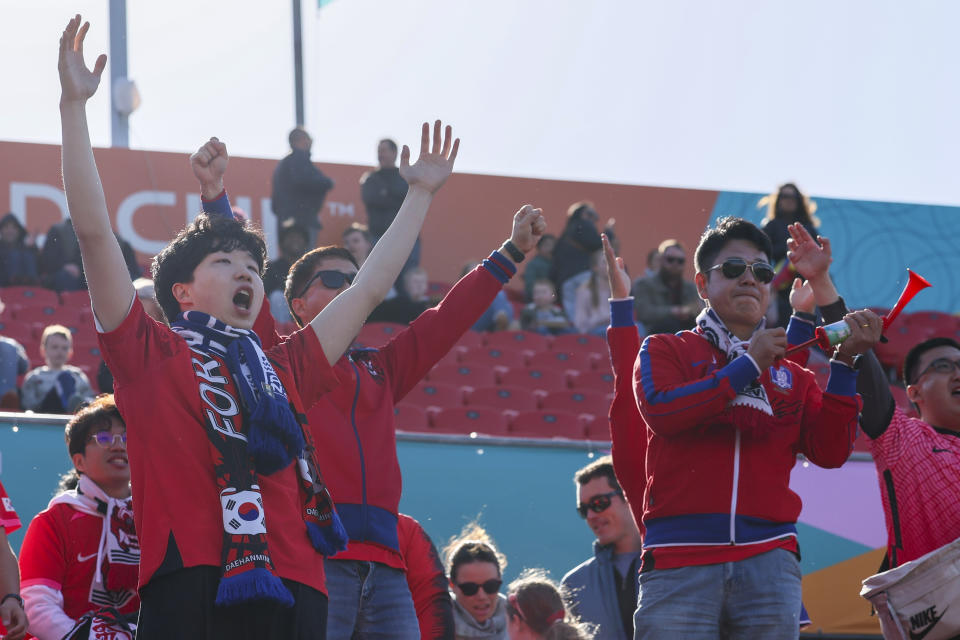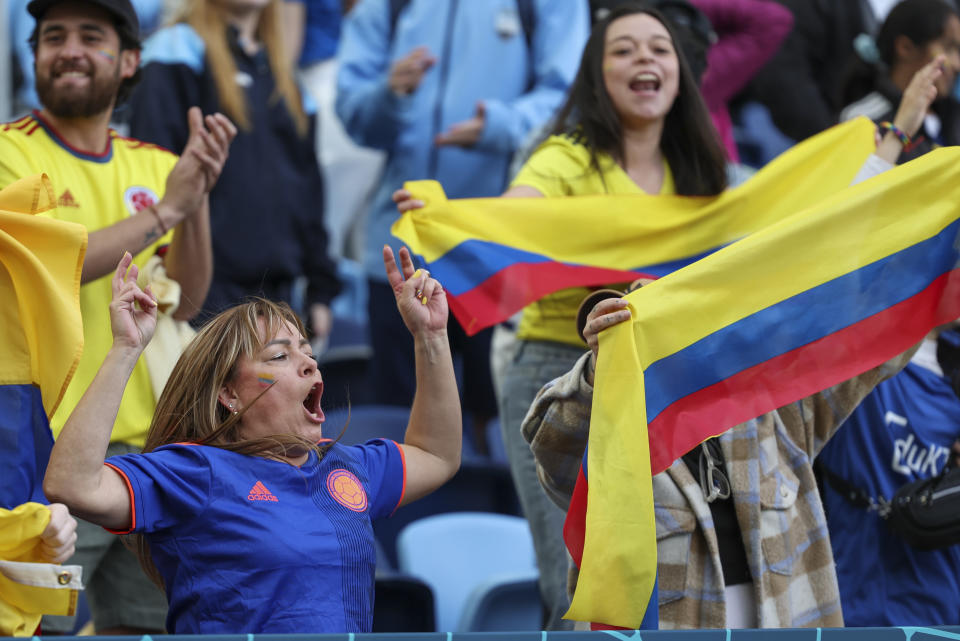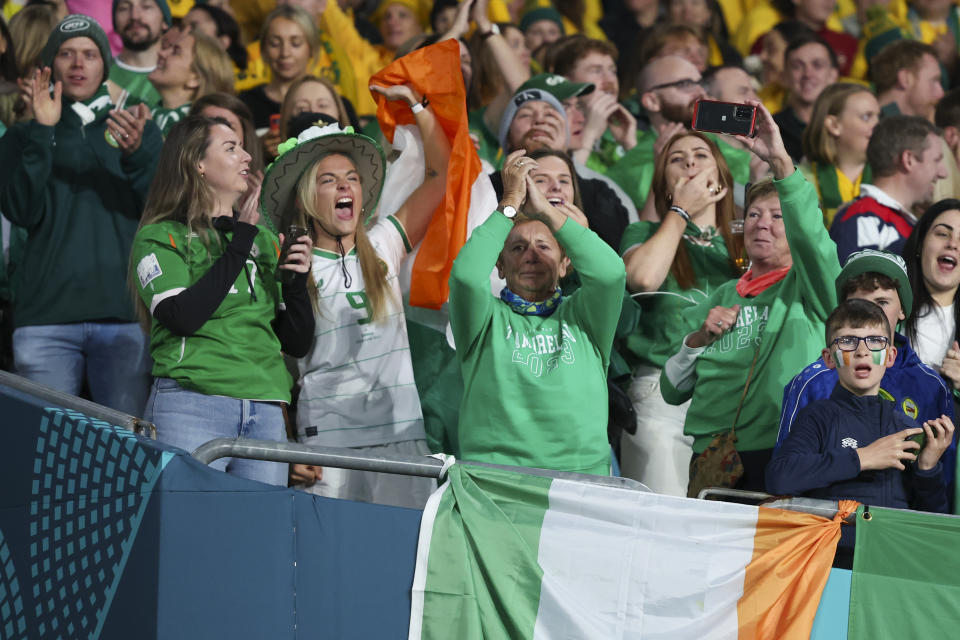Pockets of passionate fans in Australia not fully tied to Matildas' fate at the Women's World Cup
MELBOURNE, Australia (AP) — When Nigeria scored its third goal in the Women’s World Cup match that now has co-host Australia on the brink of elimination, the hundreds of Matildas fans watching on a giant screen in Melbourne’s Federation Square sent up a chorus of groans.
In the sea of yellow and green jerseys, though, a few spectators cheered and exchanged high-fives.
“You can see the joy all over here,” Nigeria fan Juwon Fayomi said.
The Matildas’ 3-2 loss to Nigeria sent the tournament co-hosts into a must-win group-stage finale against Olympic champion Canada on Monday in Melbourne. So there's a chance Australia could be knocked out in the group stage of the Women's World Cup, a fate that no host country endured in the first eight editions.
That undoubtedly could dampen some local enthusiasm. But because of Australia’s unique migration history, pockets of passionate fans still will be heavily invested in the Women’s World Cup matches.
Almost one-third of Australians are foreign-born, according to the Australian Bureau of Statistics, and 51.5% have a parent born overseas.
“We often think of the United States as the great migrant-receiver country, but actually, the percentage of foreign-born is higher in Australia,” said demographer Elin Charles-Edwards, a University of Queensland professor.
The 2023 World Cup is being co-hosted by Australia and New Zealand, and ticket sales have set records.
In the knockout rounds, Australia will host five of the eight round-of-16 matches, two quarterfinals, a semifinal match, as well as the third-place match and the Aug. 20 final.
Fayomi, a mechanical engineering researcher at the Royal Melbourne Institute of Technology, arrived in Australia from Nigeria about nine months ago. He attended the Super Falcons’ first group-stage match — a 0-0 draw against Canada — in Melbourne.
“I’m so proud of them,” Fayomi said. “So proud, so proud.”
The Super Falcons can guarantee themselves a spot in the knockout round with a win or draw over winless Ireland on Monday in Brisbane.
Colombia fans packed the Sydney Football Stadium’s stands for Las Cafeteras’ 2-0 win over South Korea last week. Another big crowd was expected for Colombia’s match against two-time World Cup champion Germany.
“Emotionally, it’s exciting to see the stands dressed in yellow,” Colombia player Lady Andrade said. “We didn’t think this was going to happen.”
Despite ranking 55th worldwide in national population size, at 26.6 million, according to the Australian Bureau of Statistics, Australia is ninth in the size of its population born in other countries.
The notion of “populate or perish” is ingrained in Australia’s post-colonization history, Charles-Edwards said. Early policies attracted immigrants from Northern Europe to boost the nation’s population.
Then, in the 1960s and 1970s, she said, the removal of some restrictive policies increased the number of Australian residents from nearby Asian nations and other parts of the world.
Enosky Agudelo Tang, a restaurant owner in Sydney with both Colombian and Chinese heritage, moved to Australia from Colombia nearly 17 years ago. He hadn’t seen a Colombian national team, men’s or women’s, play in person in two decades – until Colombia’s World Cup win over South Korea.
“In South America, (soccer) is in our blood,” Agudelo Tang said. “We still love Colombia. We still love our background. We still love our culture. It’s a big deal that we can support, in our home where we live now, our country.”
When the United States and Netherlands played to a 1-1 draw in New Zealand last Thursday, Southern Cal student Aidan Miltner, who is studying abroad at the University of Melbourne, watched at the FIFA Fan Festival in Melbourne.
“It’s a sense of pride for my home country,” Miltner said. “Being abroad, being a little homesick, it’s nice to have a community out here to cheer on our team.”
Australia has the highest percentage of international university students in the world, with about one in every four students coming from abroad, according to the International Institute of Education’s Project Atlas.
Some foreign-born Australian residents are passionate not just for their home teams. They also cheer on teams from nearby countries. Daniel Dodoo is from Ghana and Raymond Ndikontar from Cameroon, but they both were cheering for Nigeria in its match against Australia.
“Nigeria is representing West Africa, and because (Ghana) didn’t get to qualify for the World Cup, I came to support them,” Dodoo said.
Of the top 20 countries that foreign-born Australian residents hail from, half have teams competing in this year’s Women’s World Cup.
“A World Cup is something that culturally brings people together,” Charles-Edwards said. “It’s very easy to support the Matildas but also have another team that you’re backing during the World Cup. So that just, I think, adds to the excitement and to the interest in the sport.”
—-
Zeke Palermo contributed reporting from Sydney. Palermo and Cassidy Hettesheimer are students at the University of Georgia’s Carmical Sports Media Institute.
—
AP Women’s World Cup coverage: https://apnews.com/hub/fifa-womens-world-cup and https://twitter.com/AP_Sports




